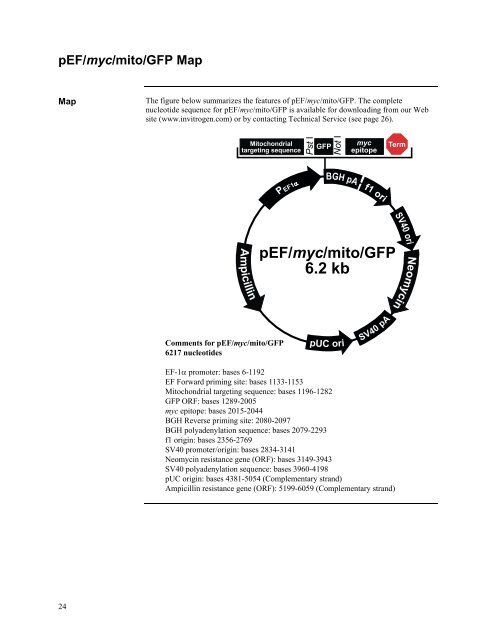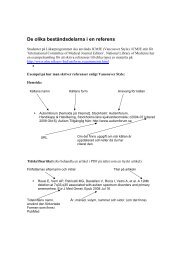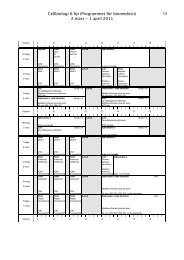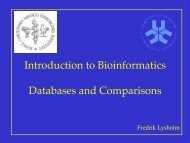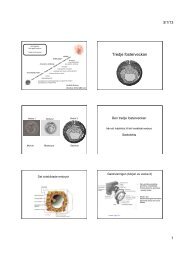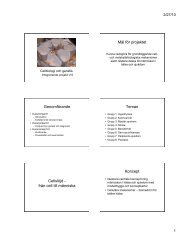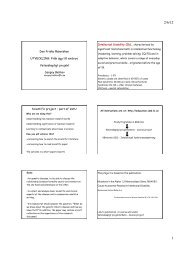pEF-myc-mito-GFP - CMB Education
pEF-myc-mito-GFP - CMB Education
pEF-myc-mito-GFP - CMB Education
Create successful ePaper yourself
Turn your PDF publications into a flip-book with our unique Google optimized e-Paper software.
<strong>pEF</strong>/<strong>myc</strong>/<strong>mito</strong>/<strong>GFP</strong> Map<br />
Map<br />
The figure below summarizes the features of <strong>pEF</strong>/<strong>myc</strong>/<strong>mito</strong>/<strong>GFP</strong>. The complete<br />
nucleotide sequence for <strong>pEF</strong>/<strong>myc</strong>/<strong>mito</strong>/<strong>GFP</strong> is available for downloading from our Web<br />
site (www.invitrogen.com) or by contacting Technical Service (see page 26).<br />
Mitochondrial<br />
targeting sequence<br />
Pst I<br />
<strong>GFP</strong><br />
Not I<br />
<strong>myc</strong><br />
epitope<br />
Term<br />
P EF1a<br />
BGH pA<br />
f1 ori<br />
SV40 ori<br />
Ampicillin<br />
<strong>pEF</strong>/<strong>myc</strong>/<strong>mito</strong>/<strong>GFP</strong><br />
6.2 kb<br />
Neo<strong>myc</strong>in<br />
Comments for <strong>pEF</strong>/<strong>myc</strong>/<strong>mito</strong>/<strong>GFP</strong><br />
6217 nucleotides<br />
pUC ori<br />
SV40 pA<br />
EF-1a promoter: bases 6-1192<br />
EF Forward priming site: bases 1133-1153<br />
Mitochondrial targeting sequence: bases 1196-1282<br />
<strong>GFP</strong> ORF: bases 1289-2005<br />
<strong>myc</strong> epitope: bases 2015-2044<br />
BGH Reverse priming site: 2080-2097<br />
BGH polyadenylation sequence: bases 2079-2293<br />
f1 origin: bases 2356-2769<br />
SV40 promoter/origin: bases 2834-3141<br />
Neo<strong>myc</strong>in resistance gene (ORF): bases 3149-3943<br />
SV40 polyadenylation sequence: bases 3960-4198<br />
pUC origin: bases 4381-5054 (Complementary strand)<br />
Ampicillin resistance gene (ORF): 5199-6059 (Complementary strand)<br />
24
Appendix<br />
Features of <strong>pEF</strong> Plasmids<br />
Table<br />
The table below summarizes the features of the pShooter vectors. These vectors were<br />
derived from pcDNA3. Changes to the vector backbone are noted. In addition, features<br />
that are unique to one vector are noted.<br />
Feature<br />
Human EF- SURPRWHU<br />
Mitochondrial targeting<br />
sequence<br />
<strong>pEF</strong>/<strong>myc</strong>/<strong>mito</strong> only<br />
ER signal peptide<br />
<strong>pEF</strong>/<strong>myc</strong>/ER only<br />
Multiple cloning site<br />
Nuclear targeting sequence<br />
<strong>pEF</strong>/<strong>myc</strong>/nuc only<br />
c-<strong>myc</strong> epitope<br />
(Glu-Gln-Lys-Leu-Ile-Ser-<br />
Glu-Glu-Asp-Leu)<br />
ER retention signal<br />
<strong>pEF</strong>/<strong>myc</strong>/ER only<br />
TAG termination codon<br />
Bovine growth hormone<br />
(BGH) polyadenylation signal<br />
f1 origin<br />
SV40 early promoter and<br />
origin<br />
Neo<strong>myc</strong>in resistance gene<br />
SV40 polyadenylation signal<br />
pUC origin<br />
Ampicillin resistance gene<br />
( -lactamase)<br />
Benefit<br />
Permits efficient, high-level expression of your recombinant<br />
protein (Kim et al., 1990; Mizushima and Nagata, 1990; Uetsuki<br />
et al., 1989). For more detailed information on this promoter,<br />
please see the next page.<br />
Allows efficient targeting to the <strong>mito</strong>chondria. Isolated from<br />
subunit VIII of human cytochrome c oxidase (Rizzuto et al.,<br />
1992).<br />
Directs the protein of interest to the ER for retention in the ER or<br />
secretion. This is the signal peptide from a mouse V h chain<br />
(Kabat et al., 1987).<br />
Allows insertion of your gene.<br />
Permits efficient targeting of your protein to the nucleus.<br />
Sequence is triplicated to ensure proper localization. Isolated<br />
from SV40 large T antigen (Fisher-Fantuzzi and Vesco, 1988).<br />
Allows detection of your recombinant protein by<br />
immunofluorescence with the Anti-<strong>myc</strong> Antibody (Catalog no.<br />
R950-25) (Evan et al., 1985).<br />
Permits retention of your protein in the ER (Munro and Pelham,<br />
1987).<br />
For efficient termination of translation.<br />
Efficient transcription termination and polyadenylation of mRNA<br />
(Goodwin and Rottman, 1992).<br />
Allows rescue of single-stranded DNA.<br />
Allows efficient, high-level expression of the neo<strong>myc</strong>in<br />
resistance gene and episomal replication in cells expressing<br />
SV40 large T antigen (i.e. COS). Nco I site removed by sitedirected<br />
mutagenesis.<br />
Selection of stable transfectants in mammalian cells (Southern<br />
and Berg, 1982). Tn5 sequence removed and the Kozak sequence<br />
improved by PCR at the 5´ end of the ORF. Nco I, Pst I, and<br />
BssH II sites removed by site-directed mutagenesis.<br />
Efficient transcription termination and polyadenylation of<br />
mRNA.<br />
High-copy number replication and growth in E. coli. ApaL I site<br />
removed by site-directed mutagenesis.<br />
Selection of vector in E. coli. ApaL I site removed by sitedirected<br />
mutagenesis.<br />
16
EF-1 Promoter<br />
Description<br />
The diagram below shows all the features of the EF- SURPRWHUXVHGLQWKHS6KRRWHU <br />
vectors (Mizushima and Nagata, 1990). Features are marked as per Uetsuki, et al., 1989.<br />
The original sequence has been mutagenized to remove the Pst I, Bgl II, Afl II, and Xho I<br />
restriction sites. In addition, Kpn I, EcoR I, Hind III, Pml I, and Nco I were introduced by<br />
PCR. The EF-1 SURPRWHUFDQEHH[FLVHGXVLQJKpn I, EcoR I, or Hind III and Pml I or<br />
Nco I.<br />
1<br />
61<br />
Kpn I EcoR I Hind III<br />
GTACCGAATT CAAGCTTCGT GAGGCTCCGG TGCCCGTCAG TGGGCAGAGC GCACATCGCC<br />
CACAGTCCCC GAGAAGTTGG GGGGAGGGGT CGGCAATTGA ACCGGTGCCT AGAGAAGGTG<br />
121<br />
181<br />
241<br />
301<br />
GCGCGGGGTA AACTGGGAAA GTGATGTCGT GTACTGGCTC CGCCTTTTTC CCGAGGGTGG<br />
TATA box<br />
Start of Transcription<br />
GGGAGAACCG TATATAAGTG CAGTAGTCGC CGTGAACGTT CTTTTTCGCA ACGGGTTTGC<br />
Exon I<br />
5´ end of Intron 1<br />
CGCCAGAACA CAGGTAAGTG CCGTGTGTGG TTCCCGCGGG CCTGGCCTCT TTACGGGTTA<br />
TGGCCCTTGC GTGCCTTGAA TTACTTCCAC CTGGCTCCAG TACGTGATTC TTGATCCCGA<br />
361<br />
GCTGGAGCCA GGGGCGGGCC TTGCGCTTTA GGAGCCCCTT CGCCTCGTGC TTGAGTTGAG<br />
421<br />
GCCTGGCCTG GGCGCTGGGG CCGCCGCGTG CGAATCTGGT GGCACCTTCG CGCCTGTCTC<br />
481<br />
GCTGCTTTCG ATAAGTCTCT AGCCATTTAA AATTTTTGAT GACCTGCTGC GACGCTTTTT<br />
541<br />
601<br />
661<br />
721<br />
781<br />
841<br />
901<br />
961<br />
TTCTGGCAAG ATAGTCTTGT AAATGCGGGC CAGGATCTGC ACACTGGTAT TTCGGTTTTT<br />
Sp 1 Sp 1<br />
GGGCCCGCGG CCGGCGACGG GGCCCGTGCG TCCCAGCGCA CATGTTCGGC GAGGCGGGGC<br />
CTGCGAGCGC GGCCACCGAG AATCGGACGG GGGTAGTCTC AAGCTGGCCG GCCTGCTCTG<br />
Sp 1 Sp 1<br />
GTGCCTGGCC TCGCGCCGCC GTGTATCGCC CCGCCCTGGG CGGCAAGGCT GGCCCGGTCG<br />
GCACCAGTTG CGTGAGCGGA AAGATGGCCG CTTCCCGGCC CTGCTCCAGG GGGCTCAAAA<br />
Sp 1<br />
TGGAGGACGC GGCGCTCGGG AGAGCGGGCG GGTGAGTCAC CCACACAAAG GAAAAGGGCC<br />
Ap 1<br />
TTTCCGTCCT CAGCCGTCGC TTCATGTGAC TCCACGGAGT ACCGGGCGCC GTCCAGGCAC<br />
CTCGATTAGT TCTGGAGCTT TTGGAGTACG TCGTCTTTAG GTTGGGGGGA GGGGTTTTAT<br />
1021<br />
GCGATGGAGT TTCCCCACAC TGAGTGGGTG GAGACTGAAG TTAGGCCAGC TTGGCACTTG<br />
1081<br />
1141<br />
ATGTAATTCT CCTTGGAATT TGGCCTTTTT GAGTTTGGAT CTTGGTTCAT TCTCAAGCCT<br />
3´ end of Intron 1<br />
Pml I Nco I<br />
CAGACAGTGG TTCAAAGTTT TTTTCTTCCA TTTCAGGTGT CGTGAACACG TGGCCACC ATG G..<br />
5´ end of Exon 2<br />
Met ...<br />
17


